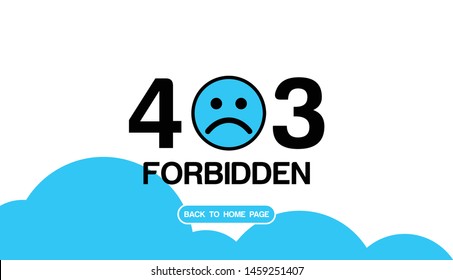HTTP ERRORS 403
HTTP 403
The HTTP 403 is an HTTP status code meaning access to the requested resource is forbidden. The server understood the request, but will not fulfill it.
Specifications
HTTP 403 provides a distinct error case from HTTP 401; while HTTP 401 is returned when the client has not authenticated, and implies that a successful response may be returned following valid authentication, HTTP 403 is returned when the client is not permitted access to the resource despite providing authentication such as insufficient permissions of the authenticated account.
Error 403: "The server understood the request, but is refusing to authorize it."
Error 401: "The request requires user authentication. The response MUST include a WWW-Authenticate header field (section 14.47) containing a challenge applicable to the requested resource. The client MAY repeat the request with a suitable Authorization header field (section 14.8). If the request already included Authorization credentials, then the 401 response indicates that authorization has been refused for those credentials."
The Apache web server returns 403 Forbidden in response to requests for URL paths that correspond to file system directories when directory listings have been disabled in the server and there is no Directory Index directive to specify an existing file to be returned to the browser. Some administrators configure the Mod proxy extension to Apache to block such requests and this will also return 403 Forbidden. Microsoft IIS responds in the same way when directory listings are denied in that server. In WebDAV, the 403 Forbidden response will be returned by the server if the client issued a PROPFIND request but did not also issue the required Depth header or issued a Depth header of infinity.
The following nonstandard codes are returned by Microsoft's Internet Information Services, and are not officially recognized by IANA.
Substatus error codes for IIS
403.1 – Execute access forbidden
403.2 – Read access forbidden
403.3 – Write access forbidden
403.4 – SSL required
403.5 – SSL 128 required
403.6 – IP address rejected
403.7 – Client certificate required
403.8 – Site access denied
403.9 – Too many users
403.10 – Invalid configuration
403.11 – Password change
403.12 – Mapper denied access
403.13 – Client certificate revoked
403.14 – Directory listing denied
403.15 – Client Access Licenses exceeded
403.16 – Client certificate is untrusted or invalid
403.17 – Client certificate has expired or is not yet valid
403.18 – Cannot execute request from that application pool
403.19 – Cannot execute CGIs for the client in this application pool
403.20 – Passport logon failed
403.21 – Source access denied
403.22 – Infinite depth is denied
403.502 – Too many requests from the same client IP; Dynamic IP Restriction limit reached
403.503 – Rejected due to IP address restriction.
See also icon Internet portal List of HTTP status codes URL redirection References
Hypertext Transfer Protocol (HTTP/1.1): Semantics and Content. IETF.
"HTTP Extensions for Web Distributed Authoring and Versioning (WebDAV)". IETF. June 2007. Archived from the original on March 3, 2016. Retrieved January 11, 2016.
External links
Apache Module mod_proxy – Forward
Working with SELinux Contexts Labeling files
Hypertext Transfer Protocol (HTTP/1.1): Semantics and Content
Error messages
System failure:-
Bomb iconFatal system errorGuru MeditationKernel panicLinux kernel oopsRed Ring of DeathSad MacScreen of death BlueBlack
Application failure:-
ABENDFatal exception errorSegmentation fault
Device and data errors:-
HTTP 403HTTP 404HTTP 500lp0 on fireNot a typewriterPC LOAD LETTER
Other:-
Abort, Retry, Fail?Bad command or file nameHalt and Catch FireHTTP 418Out of memory
Lists:-
List of HTTP status codesList of FTP server return codesList of SMTP server return codes
Related:-
Spinning pinwheelWindows wait cursor

Comments
Post a Comment